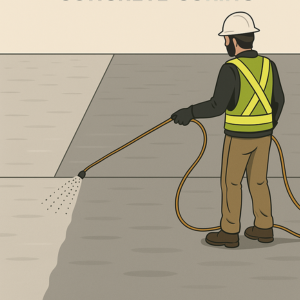CURING
 |
|||

Once concrete is Placed and Finished, Hydration begins immediately as water reacts with the Cement. During this stage, it’s important to protect the Concrete surface from premature moisture loss caused by heat, wind, or low humidity.
Final Setting and Early Curing (2–24 hours after placement)
The Concrete transitions from a Plastic state to a Hardened form. Initial set typically occurs within 2 to 4 hours, and final set between 4 to 10 hours, depending on the mix design and environmental conditions.
Curing should begin as soon as the surface is firm enough not to be damaged. Techniques include spraying water, applying curing compounds, covering with wet burlap, or using plastic sheeting. The goal is to retain moisture and promote uninterrupted hydration.
Active Curing Period (1–7 days)
This is the most critical period for curing. Cement hydration is active and rapid, especially in the first three days. Maintaining consistent moisture and temperature is essential to prevent cracking and ensure proper strength gain. By the seventh day, the concrete often reaches about 70 percent of its 28-day strength. Standard curing methods continue to be effective during this stage.
Extended Curing (7–28 days)
Although the Concrete has hardened, hydration continues. Extended curing may be necessary for structural elements exposed to harsh environments, for high-performance Concrete, or in hot, dry, or windy conditions. Ordinary Portland Cement concrete typically reaches its design strength by 28 days, assuming proper curing.
Post-Curing and Long-Term Hydration (after 28 days)
Formal Curing usually ends at 28 days, but cement hydration can continue for months or even years if moisture remains available. This contributes to ongoing strength gain, reduced permeability, and improved durability over the concrete’s service life.
Shining a light on over 80 Construction Categories, with unlimited potential for Sub Categories - Watch our Community grow!

